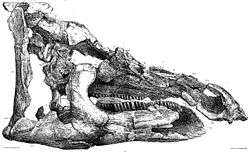Telmatosaurus
| Telmatosaurus Temporal range: Late Cretaceous, 70–66 Ma | |
|---|---|
 | |
| Holotype skull | |
| Scientific classification | |
| Kingdom: | Animalia |
| Phylum: | Chordata |
| Class: | Reptilia |
| Superorder: | Dinosauria |
| Order: | Ornithischia |
| Family: | Hadrosauridae |
| Genus: | Telmatosaurus Nopcsa, 1903 |
| Species | |
| |
| Synonyms | |
| |
Telmatosaurus (meaning "marsh lizard") is a genus of basal hadrosaurid dinosaur from the Late Cretaceous. It was a relatively small hadrosaur, approximately five meters (16 ft) long, found in what is now Romania.
Discovery

In 1895 some peasants presented Ilona Nopcsa, the daughter of their lord, with a dinosaur skull they had found at the estate Săcele in the district Hunedoara (then named Hunyad) in Transylvania. Ilona had an elder brother, Ferenc or Franz Nopcsa von Felső-Szilvás who was inspired by the find to become a paleontology student at the University of Vienna. In 1899 Nopcsa named the skull Limnosaurus transsylvanicus. The generic name was derived from Greek λιμνή, limné, "swamp", a reference to the presumed swamp-dwelling habits of hadrosaurs. The specific name referred to Transylvania.[1] Later Nopcsa discovered that the name Limnosaurus had already been used by Othniel Charles Marsh in 1872 for a crocodilian (later reclassified as Pristichampsus), so in 1903 Nopcsa renamed the genus Telmatosaurus. Telma again means "marsh".[2] In 1910 Barnum Brown, unaware of Nopcsa's replacement name, named the genus Hecatasaurus,[3] but this is a junior objective synonym.
The holotype, BMNH B.3386, was found in the Haţeg Basin in a layer of the Sânpetru Formation dating from the Maastrichtian, about 68 million years old, at the time part of the Haţeg Island, one of the islands of the European Archipelago. It consists of a skull with lower jaws.
In 1915 Nopcsa referred his species to the genus Orthomerus, as an Orthomerus transsylvanicus.[4] However, since the 1980s, Orthomerus has been considered a nomen dubium, leading to a revival of the name Telmatosaurus. Fragmentary hadrosauroid material from Spain, France and Germany, that had been referred to Orthomerus, is now often assigned to Telmatosaurus, but an identity is hard to prove; the same is also true of many Romanian fragments and eggs.[5]
Description
The relatively small size of Telmatosaurus with a length of five metres and a weight of half a tonne, has been explained as an instance of insular dwarfism.
Paleopathology
A young Telmatosaurus examined by Bruce Rothschild and Kate Acheson et al has a large non-cancerous tumor called an ameloblastoma on its lower jaw. The presence of this benign tumor in a dinosaur is a first, as before the discovery, ameloblastomas were known only from modern reptiles. It remains unknown if the tumor contributed to the hadrosaur's demise.[6]
See also
Notes
- ↑ F. Nopcsa, 1900, "Dinosaurierreste aus Siebenbürgen (Schädel von Limnosaurus transsylvanicus nov. gen. et spec.)", Denkschriften der Kaiserlichen Akademie der Wissenschaften. Mathematisch-Naturwissenschaftliche Classe 68: 555-591
- ↑ F. Nopcsa, 1903, "Telmatosaurus, new name for the dinosaur Limnosaurus", Geological Magazine, decade 4 10: 94-95
- ↑ B. Brown, 1910, "The Cretaceous Ojo Alamo beds of New Mexico with description of the new dinosaur genus Kritosaurus", Bulletin of the American Museum of Natural History 28(24): 267-274
- ↑ F. Nopcsa, 1915, "Die dinosaurier der Siebenbürgischen landesteile Ungarns", Mitteilungen aus dem Jahrbuche der Königlich-Ungarischen Geologischen Reichsanstalt 23: 1-24
- ↑ F.M. Dalla Vecchia, 2006, "Telmatosaurus and the other hadrosaurids of the Cretaceous European Archipelago. An overview", Natura Nascosta 32: 1-55
- ↑ https://www.sciencedaily.com/releases/2016/07/160705092005.htm